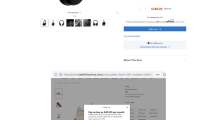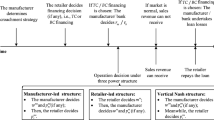Abstract
Currently, an increasing number of retailers are hiring purchasing agents to source products from upstream manufacturers instead of sourcing directly themselves. The retailers’ choices of purchasing agents are influenced not only by the agents’efficiencies and costs, but also by the competitors’ purchasing strategies. On this basis, this study establishes a Nash game model to investigate two competing retailers’ sourcing strategies from a common manufacturer: purchasing themselves with a base wholesale price or purchasing through an agent with a lower wholesale price. We find that, for the retailers, when both retailers choose a purchasing agent, it is not always superior to the case in which neither of them does; this completely depends on the agent’s efficiency and has nothing to do with the agency fee. Second, regardless of the competitor’s strategy, the retailer always chooses to hire an agent if the efficiency of the agent is relatively high and the cost is sufficiently low, which can yield a lower wholesale price at an acceptable agency fee. Finally, we verify that a Nash equilibrium can be achieved only when the two retailers have the same purchasing strategy, i.e., neither of the retailers hires a purchasing agent or both of them do, and the case in which only one retailer hires an agent is never an equilibrium.


Similar content being viewed by others
References
Bian J, Zhao X (2019) Tax or subsidy? An analysis of environmental policies in supply chains with retail competition. Eur J Oper Res 283(3):901–914
Dong B, Tang W, Zhou C, Ren Y (2019) Should original equipment manufacturer assist noncompetitive contract manufacturer to expand capacity? Omega 203(9):1–12
Firouz M, Keskin B (2017) An integrated supplier selection and in-ventory problem with multi-sourcing and lateral transshipments. Omega 70:77–93
He P, Wang Z, Shi V, Liao Y (2021) The direct and cross effects in a supply chain with consumers sensitive to both carbon emissions and delivery time. Eur J Oper Res 292(1):172–183
Huang Y, Hong J, Jian H, Tseng T (2015) Quantity discount coordination for supply chains with deteriorating inventory. Comput Ind Eng 152(1):1–9
Li W, Chen J (2018) Backward integration strategy in a retailer stackelberg supply chain. Omega 75:118–130
Liu Q, Zhang X, Huang S, Zhang L, Zhao Y (2020) Exploring consumers’ buying behavior in a large online promotion activity: the role of psychological distance and involvement. J Theor App El Comm 15:66–80
Liu L, Zhao Q, Gonzalezc E, Xi X (2021) Sourcing and production decisions for perishable items under quantity discounts and its impacts on environment. J Clean Prod 317:1–13
McGuire T, Staelin R (1983) An industry equilibrium analysis of downstream vertical integration. Mark Sci 2(2):161–191
Niu B, Li J, Zhang J, Cheng H, Tang Y (2019) Strategic analysis of dual sourcing and dual channel with an unreliable alternative supplier. Prod Oper Manage 28(3):570–587
Satheesh S, Debabrata T (2016) Competitive effects of Wal-Mart supercenter entry: moderating roles of category and brand characteristics. J Retail 92(2):218–225
Shi X, Dong C, Zhang C, Zhang X (2019) Who should invest in clean technologies in a supply chain with competition? J Clean Prod 215:689–700
Wang F, Zhou X, Niu B, He J (2017) Who canvasses for cargos? Incentive analysis and channel structure in a shipping supply chain. Transport Res B-Meth 97(3):78–101
Xu G, Chen H, Wu X, Zhou C (2020) Game analysis on green cost-sharing between competing supply chains. J Syst Eng 32(2):244–256
Yan Y, Zhao R, Lan Y (2018) Asymmetric retailers with different moving sequences: group buying vs. individual purchasing. Eur J Oper Res 261(3):903–917
Zhou Y, Guo J, Zhou W (2018) Pricing/service strategies for a dual-channel supply chain with free riding and service-cost sharing. Int J Prod Econ 196:198–210
Acknowledgements
This paper is supported by the National Natural Science Foundation of China (no: 61702389, no: 12001413) and Yanta Scholars Foundation of Xi’an University of Finance and Economics.
Author information
Authors and Affiliations
Corresponding author
Ethics declarations
Conflict of interest
The authors declare no conflict of interest.
Additional information
Publisher's Note
Springer Nature remains neutral with regard to jurisdictional claims in published maps and institutional affiliations.
Appendix 1
Appendix 1
Proof of Lemma 4
From Lemmas 1 and 3, we have \(\Pi _{\text {R}_1}^{\text {AA}}-\Pi _{\text {R}_1}^{\text {NN}}=-\frac{\varphi (-w^2+\mu )}{-9\varphi w^2+9\mu }\). From \(\Pi _{\text {R}_1}^{\text {AA}}-\Pi _{\text {R}_1}^{\text {NN}} > 0\), we obtain \(\mu <w^2\), otherwise \(\Pi _{\text {R}_1}^{\text {AA}}-\Pi _{\text {R}_1}^{\text {NN}} < 0\). This completes the proof. \(\square\)
Proof of Lemma 5
From Lemmas 1 and 2, we obtain \(\Pi _{\text {R}_1}^{\text {AN}} - \Pi _{\text {R}_1}^{\text {NN}} = \frac{\varphi Q}{9(4\varphi w^2-3\mu )^2}\), where \(Q = ( - 16w^4 + 9\mu w^2)\varphi + 15\mu w^2 - 9\mu ^2\). When \(\mu > \frac{16w^2}{9}\), \(Q < 0\), and thus \(\Pi _{\text {R}_1}^{\text {AN}} - \Pi _{\text {R}_1}^{\text {NN}} < 0\); When \(\frac{16w^2}{9}> \mu > \frac{15w^2}{9}\), \(Q<0\) and thus \(\Pi _{\text {R}_1}^{\text {AN}} - \Pi _{\text {R}_1}^{\text {NN}} < 0\); When \(\frac{15w^2}{9} > \mu\), let \(Q=0\) and we obtain \(\phi _1 = \frac{(9\mu -15w^2)\mu }{(9\mu -16w^2)w^2}\). Therefore, we have \(Q < 0\) and thus \(\Pi _{\text {R}_1}^{\text {AN}} - \Pi _{\text {R}_1}^{\text {NN}} < 0\) if \(\phi > \phi _1\), otherwise \(\Pi _{\text {R}_1}^{\text {AN}} - \Pi _{\text {R}_1}^{\text {NN}} > 0\). \(\square\)
Proof of Lemma 6
From Lemmas 2 and 3, we obtain \(\Pi _{\text {R}_1}^{\text {AA}} - \Pi _{\text {R}_2}^{\text {AN}} = \frac{M}{9(4\varphi w^2-3\mu )^2(\varphi w^2 - \mu )}\), where \(M = (-36w^6 + 16\mu w^4)\varphi ^2 + (56\mu w^4 - 24\mu ^2 w^2)\varphi - 21w^2\mu ^2 + 9\mu ^3\). When \(\mu > \frac{7w^2}{3}\), \(M > 0\) and thus \(\Pi _{\text {R}_1}^{\text {AA}} - \Pi _{\text {R}_2}^{\text {AN}} < 0\); When \(\frac{7w^2}{3}> \mu > \frac{9w^2}{4}\), let \(M = 0\) and we obtain \(\phi _2 = \frac{(-14w^2+6\mu +\root 2 \of {7W^4-3\mu w^2})\mu }{2(4\mu -9w^2)w^2}\). Therefore, we have \(M > 0\) and thus \(\Pi _{\text {R}_1}^{\text {AA}} - \Pi _{\text {R}_2}^{\text {AN}} < 0\) if \(\phi > \phi _2\), otherwise \(\Pi _{\text {R}_1}^{\text {AA}} - \Pi _{\text {R}_2}^{\text {AN}} > 0\); When \(\frac{9w^2}{4} > \mu\), \(M > 0\) and thus \(\Pi _{\text {R}_1}^{\text {AA}} - \Pi _{\text {R}_2}^{\text {AN}} < 0\). \(\square\)
Proof of Proposition 2
\(\Pi _\mathrm{{P}}^{{\text {AA}}} - \Pi _\mathrm{{P}}^{{\text {AN}}}\) \(= -\frac{(a-w)^2\mu \varphi (101\varphi ^3 w^6 - 184\mu \varphi ^2 w^4 + 105\mu ^2\varphi w^2 - 18\mu ^3)}{(288(\varphi w^2-\mu )^2 (\varphi w^2-\frac{3}{4}\mu )^2)}\). Let \(f(\mu ) =-( 101\varphi ^3 w^6 - 184\mu \varphi ^2 w^4 + 105\mu ^2\varphi w^2 - 18\mu ^3)\), then \(f(\mu ) < 0\) in \([2\phi w^2, \frac{23}{9}\phi w^2]\) and \(f(\mu ) > 0\) in \([\frac{23}{9}\phi w^2,+\infty ]\). Hence, the function f(u) must have a root \(\mu _0\) in \([2\phi w^2, +\infty ]\) . From the above analysis we can obtain that \(\Pi _\mathrm{{P}}^{{\text {AA}}} - \Pi _\mathrm{{P}}^{{\text {AN}}}<0\) if \(\mu <\mu _0\) and \(\Pi _\mathrm{{P}}^{{\text {AA}}} - \Pi _\mathrm{{P}}^{{\text {AN}}}>0\) if \(\mu >\mu _0\). \(\square\)
Rights and permissions
About this article
Cite this article
Xu, G., Ding, P., Chen, P. et al. Analysis of the strategy of competing retailers in hiring a purchasing agent under a price discount contract. J Ambient Intell Human Comput 14, 16313–16323 (2023). https://doi.org/10.1007/s12652-022-03853-6
Received:
Accepted:
Published:
Issue Date:
DOI: https://doi.org/10.1007/s12652-022-03853-6




